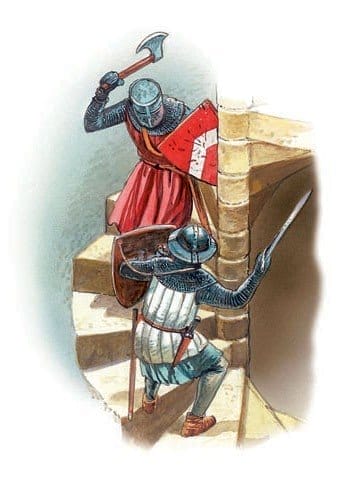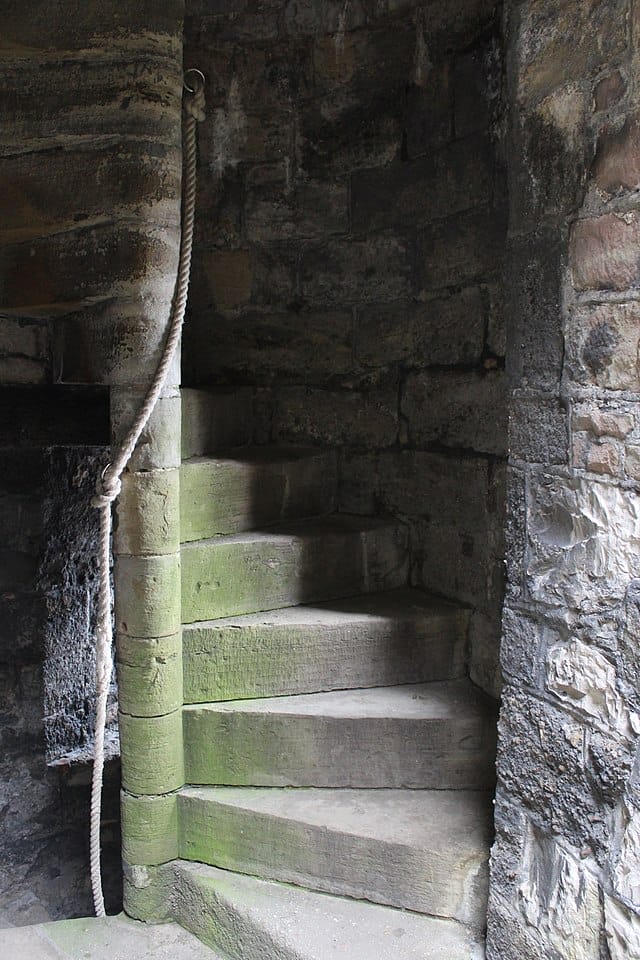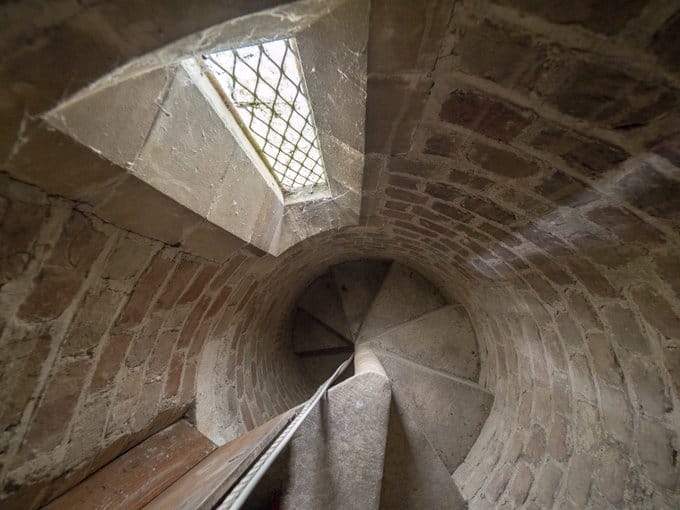From Simplicity to Sophistication
As we meander through medieval times, what we understand is that spiral staircases had evolved both in their design and mode of construction. From the primitive—simple and strong— to the most elegant and flamboyant examples of the late Middle Ages. Castles like the celebrated Château de Blois showcase spiral staircase designs built 1520. The celebrated fortress is home to an immaculately constructed double helix staircase that can be considered a tour de force in the world of fine art as well as architecture.
Materials and Methods
The materials and building techniques varied, starting from stone, which provided strength and durability, to wood, which added warmth and flexibility in design. The advancements in construction methods also allowed for more intricate designs and the ability to incorporate spiral staircases into various parts of a castle or a fortification.
The Symbolism and Strategic Importance of Spiral Staircases
More Than Just Stairs
Spiral staircases carried symbolic meanings in medieval times, often representing spiritual growth and the journey towards enlightenment. This symbolism was beautifully intertwined with their practical uses, adding a layer of depth to their architectural significance.
A Strategic Masterpiece
Strategically, these staircases were a masterstroke. Positioned in a clockwise direction (from the top looking down), they favored right-handed defenders descending the stairs, allowing them to wield their swords more freely while attackers, climbing up, were hindered by the central column. Note ; In researching this article I came across plenty of researchers who believe that this is unlikely as once attackers are in the castle then the game is already up. Also when I visited Caernarfon Castle in Wales I was profoundly disappointed to discover the spiral staircase was, in fact, anticlockwise ascending (see picture) then I found the same in medieval spiral stairs in The Tower of London. However, as it creates such a fabulous romantic image I have left the point in this article and you can decide for yourself.



Spiralling Sanctuaries: The Church’s Ascension
In the heart of medieval spirituality and community life stood the church, often crowned with its own distinctive spiral staircases. These weren’t just architectural features; they were pathways to the heavens, symbolically elevating congregants closer to the divine. In cathedrals and churches, spiral staircases did more than connect floors; they led to bell towers and lofted spaces, where the toll of bells would call the faithful to prayer and mark the passage of time. The ascent through these tight, winding stairs was a physical act of devotion, mirroring the spiritual journey of the faithful towards enlightenment and closeness with God. Example – Bell tower spiral staircase – Church of St. Maurice – Czech Republic (circa 1412) – Metal handrail added much later.
Architectural Marvels of Medieval Worship
Notably, the construction of spiral staircases in churches during the medieval period showcased an incredible blend of functionality, beauty, and symbolic meaning. The famed spiral staircase of Lichfield Cathedral in England, for example, not only provided access to the upper levels of the cathedral but also stood as a testament to medieval craftsmanship and the church’s role as a beacon of hope and faith. These staircases were often built with such precision and artistry that they seemed to defy the technological limits of the time, inspiring awe and wonder in all who beheld them. Example – Medieval Church Spiral Staircase – St Andrew’s – Wood Walton


The Legacy of Sacred Spirals
The legacy of spiral staircases in medieval churches extends far beyond their structural and functional roles. They represent a tangible link to the past, embodying the spiritual aspirations and architectural achievements of the Middle Ages. Today, these sacred spirals continue to captivate visitors, offering a unique perspective on the medieval church’s influence on society and the enduring power of faith expressed through architecture. Whether climbing the narrow steps to a church tower or admiring from below, the experience of a spiral staircase in a medieval church is to walk in the footsteps of history, sharing in the same spiritual journey that has uplifted hearts for centuries.
The Evolution or, I can’t resist, The Revolution
Between the early examples from around 1200, the evolution of the spiral staircase in Europe reflected broader trends in architecture and society, transitioning from the robust, utilitarian structures of the early medieval period to the more intricate and stylistically sophisticated designs of the late Middle Ages and early Renaissance. Initially, spiral staircases in castles and fortifications were primarily functional, designed to provide strategic advantages during sieges and battles. However, as architectural techniques advanced and the societal focus shifted towards more peaceful and prosperous times, the aesthetic aspects of spiral staircases became increasingly important. By the 15th century, these staircases were not just about defense; they were also symbols of status and beauty. Craftsmen experimented with lighter materials and more elaborate designs, incorporating intricate stone carvings and wider, more comfortable steps. This period saw the spiral staircase become a feature of not only military and religious buildings but also of grand domestic architecture, reflecting the growing importance of personal comfort, artistic expression, and social status in the architectural landscape of Europe. Two striking examples of this evolution can be seen in Musée de Cluny and Chateau de Blois. (circa 1515)


Call to Action
Feeling inspired? Why not visit some local historical sites with spiral staircases to soak in some of that medieval magic firsthand? Or better yet, start imagining how you could weave a little of that historical charm into your own home. Whether you’re a history buff, an architecture enthusiast, or simply someone who appreciates the beauty of design, the spiral staircase is a testament to the enduring appeal of medieval architecture in our modern lives. Let’s embrace these architectural marvels and bring a twist of time into our homes.
Whether it’s the whispered secrets of ancient fortifications or the sleek elegance of modern designs, the story of spiral staircases is a fascinating tale of innovation, inspiration, and imagination. So, the next time you find yourself ascending a spiral staircase, remember: you’re not just stepping up; you’re walking through history.
